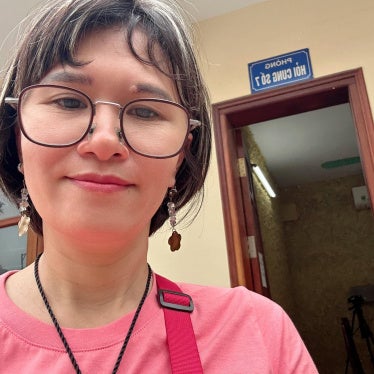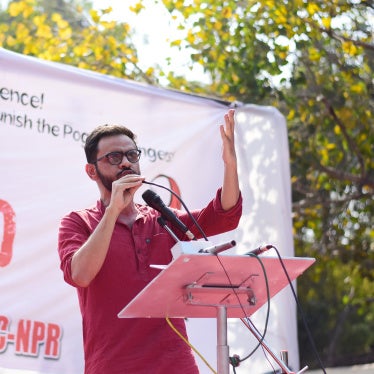(New York) – Burma’s President Thein Sein should commit to an independent investigation and fair prosecutions of officials and commanders responsible for the mass killings of pro-democracy protesters 25 years ago. Burma’s friends and donors should make clear that genuine reform in Burma means ensuring justice for victims of the 1988 massacres and other serious human rights violations.
The 1988 protests and crackdown were a watershed moment in Burma. From March to September 1988, the suppression of mass pro-democracy demonstrations throughout Burma resulted in thousands of deaths at the hands of the military and other security forces.
“The mass killings 25 years ago in Burma are an unaddressed open wound that challenges the government’s rhetoric of reform,” said Brad Adams, Asia director at Human Rights Watch. “The government should shed itself of 50 years of denial about military abuses by showing that it stands with the Burmese people and not with the killers of the past.”
On August 8, 1988, a nationwide strike involving thousands of students, Buddhist monks, civil servants, and ordinary citizens led to simultaneous protests in cities and towns across Burma, calling for a transition to democracy and an end to military rule. The size and scale of these protests surprised the government, which then ordered troops to suppress the protests with force. Troops fired on peaceful protesters, killing and wounding hundreds. While many fled, some protesters fought back with Molotov cocktails, swords, poisoned darts, and sharpened bicycle spokes, killing some policemen and other officials.
On August 10, soldiers deliberately fired on and killed doctors and nurses treating wounded civilians at Rangoon General Hospital. On August 12, Sein Lwin, who had replaced long-time dictator Ne Win as president, resigned after 17 days in power. Soldiers largely withdrew to the barracks, and an interim government, headed by civilian Dr. Maung Maung, was appointed on August 19. On August 26, an estimated one million people demonstrated at the Shwedagon Pagoda, Rangoon’s central landmark. Democracy leader Aung San Suu Kyi, who in 1991 would win the Nobel Peace Prize, was one of the day’s many speakers who defied the military government and called for an end to authoritarian rule. Daily protests continued through August and September, with demonstrators organizing local administration committees with Buddhist monks, students, and community leaders to maintain peace and order.
The military launched a coup on September 18 that established the State Law and Order Restoration Council (SLORC), chaired by Gen. Saw Maung. On September 18 and 19, 1988, soldiers returned to the streets and fired live ammunition at peaceful protesters, killing thousands. Thousands of activists were arrested and thousands more fled to neighboring countries. Student leaders, who served as the vanguard of the protests, and other activists were imprisoned for years and subjected to torture and other abuses in prison. No government officials were ever held accountable for abuses committed during the crackdown.
On the 25th anniversary of the crackdown, Human Rights Watch reiterated its call to the Burmese government to immediately release all remaining political prisoners and repeal laws used since then to prevent or curtail peaceful protests. The government should create a genuinely independent body with a broad membership to investigate the major government crackdowns since 1988 and to make recommendations for prosecutions. In addition the government should encourage a broad based truth-telling of the 1988 events and government repression since that time.
“If the government recognizes past atrocities and commits to accountability, the anniversary of 8.8.88 could be a pivotal moment in addressing decades of repressive rule,” Adams said. “It could even be the start of a new era if the military and government move from denial to admission and from impunity to justice.”
In the past few weeks, the Thein Sein government has permitted a number of unprecedented public commemorative 25th anniversary events such as concerts and art shows. A three-day commemorative event organized by former political prisoners is scheduled for the commercial capital, Rangoon, where some of the worst bloodshed occurred. Events are also being permitted in rural towns in other parts of Burma by original organizers of anti-government movements, some of whom have been allowed to return after having spent the past 25 years in exile. Previously banned books documenting the events of 1988, including Swedish journalist Bertil Lintner’s groundbreaking Outrage, are now openly sold in the country in Burmese and English.
Human Rights Watch also urged the government to establish independent inquiries into the violent suppression of peaceful protests over the past 25 years, including the student demonstrations in Rangoon in December 1996 and the Buddhist monk-led demonstrations in September 2007. Other incidents, such as the attack on Aung San Suu Kyi and her supporters in the Upper Burma town of Depayin in May 2003 that left scores dead, have never been independently investigated.
“It is important that Thein Sein’s government has permitted civil society to stage commemorative events, but the government should go further and admit military culpability and commit to ending the military’s role in all aspects of governance,” Adams said. “The brutality of the 1988 crackdown was a key factor in the past 25 years of fear that fuelled continued military rule. Addressing these abuses is absolutely necessary for Burmese society to move forward.”








